A Trip to the Desert
I have new work that I can put up since it has been well and truly launched.
The group I work with - tACTile - makes a new exhibition every two years. This year it is called Elements and was devised by Beth Miller and Helen Gray.
Each artist was to take one or more of the elements - earth, air, fire and water, and make a body of work to fill a four metre wall in any way we chose. Our collaborative this time was intended to be a sketchbook entry. A perspex piece at the top was to sandwich images we had used as inspiration, and below it we would hang sample pieces in fabrics as we played with ideas.
Frankly - the collaborative did not work. The 'jigsaws' were intended to slot together as a single piece with separate parts hanging below. Not only was the jigsaw reluctant to fit now that the perspex had sandwiched boards and images between them, but the images really did not work together. Strong ones killed the others and dominated and we could not change the order of the pieces because that had been decided from the beginning with the allocation of a unique jigsaw headpiece. We decided to hang each beside the main body of that artist's work. In retrospect it was a good decision and most people at our ANCA Gallery exhibition spent more time looking at the small ones than they did at the big ones.
Mine is based on an extraordinary trip that I have now done twice a drive to Gilf Kebir and Jebel Uweinat in the far south west of Egypt, just nudging into Sudan and Libya.
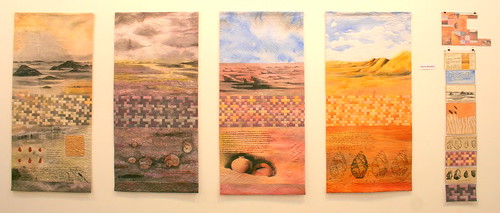
This is the blurb I wrote for the exhibition press releases, somewhat expanded.
Earth, Air and a Memory of Water
For the theme of Elements I decided to work with a recent trip across the Great Western Desert – the Sahara. We drove from the oasis of Bahariya in the Western Desert of Egypt to the Gilf Kebir – a plateau the size of Belgium at the junction of Libya, Sudan and Egypt. The trip took sixteen days, five 4 wheel drive vehicles, and we had to carry all petrol, water, and food on the cars. We saw no other car driving in the desert in that time, and the only people were desert police in one distant post. The desert almost became a living thing, the main player on the trip and the element of earth seemed to dominate.
I thought of this body of work as a series on earth – with the changing landscape and colours as we drove across it. Then I realised that the sky was a continual backdrop, so I thought of the series as Earth and Sky. Then I realised each item I used in the lowest panel has a memory of water.
I roughed out a plan for each piece on a scrap of fabric and used that as my first scrapbook piece.
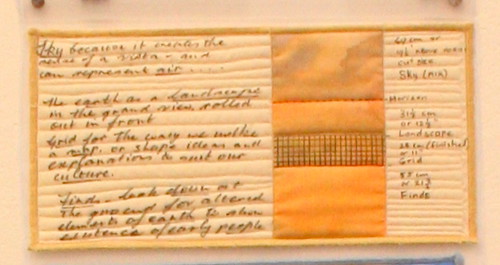
Each piece has:
1. The sky as the top panel.
2. A charcoal drawing of the desert below, showing the colours on the day that we drove across it. I wanted this and the sky to have a sense of a Victorian-style heroic vista.
3. A grid of crosses to relate to the maps we followed and the way that we continually compared what we saw to what we knew – contextualising what we saw to fit a western construct. Also - I like to include an element of traditional patchwork in my work.
4. A low section which represents the earth we walked on and the things we found on it. The marks of previous peoples were on rock walls or on the ground. I wanted viewers to have to bend to see what was there – as we did.
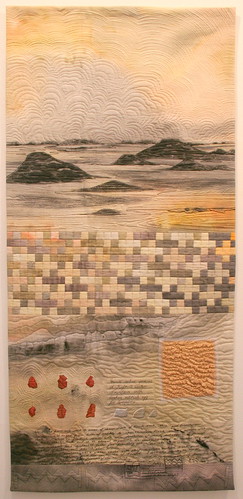
I. The Water Mountain. The codes used by ancient Egyptians for water caches the horizontal zigzag is carved into rock walls with pharaonic symbols. The ground is littered with pieces of ochre - the reason that the ancient Egyptians ventured so far into a hostile environment. There are also pieces of ostrich eggs for the making of egg tempura. 76.5 cm x 163.5 cm
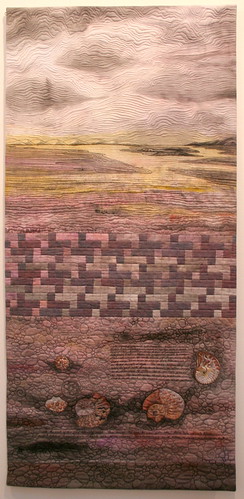
II. Ammonite Fields - fossil ammonites, sponges and coral – remnants of a great sea, long retreated. We drove over ammonites for a whole day while clouds changed the light continually and there were even a few drops of rain. 77 cm x 160 cm
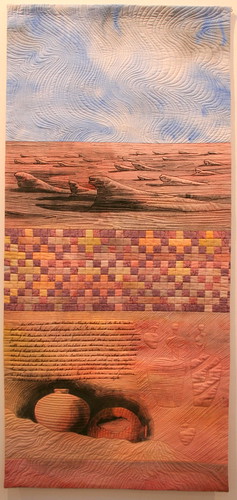
III. Abu Bellas - two water vessels, part of another water cache left by Pharaonic Egypt to enable them push further into the desert in search of ochres for painting. Beautiful fine carvings on rock walls nearby looked almost African with their big-skirted bottoms and breasts. We were the first to find these - they have not been recorded by other expeditions.

IV. Acheulean Hand Axes - an Achulean hand axe from a site where there were many in a concentrated tool scatter – proof that in the days when they were abandoned thousands of years before the coming of the pharaohs - there was enough water to sustain life. 77 cm x 161.5
I have recently returned from Birmingham with the fabulous Egyptian Tentmakers - and I am writing up a report of that. Watch this space.
The group I work with - tACTile - makes a new exhibition every two years. This year it is called Elements and was devised by Beth Miller and Helen Gray.
Each artist was to take one or more of the elements - earth, air, fire and water, and make a body of work to fill a four metre wall in any way we chose. Our collaborative this time was intended to be a sketchbook entry. A perspex piece at the top was to sandwich images we had used as inspiration, and below it we would hang sample pieces in fabrics as we played with ideas.
Frankly - the collaborative did not work. The 'jigsaws' were intended to slot together as a single piece with separate parts hanging below. Not only was the jigsaw reluctant to fit now that the perspex had sandwiched boards and images between them, but the images really did not work together. Strong ones killed the others and dominated and we could not change the order of the pieces because that had been decided from the beginning with the allocation of a unique jigsaw headpiece. We decided to hang each beside the main body of that artist's work. In retrospect it was a good decision and most people at our ANCA Gallery exhibition spent more time looking at the small ones than they did at the big ones.
Mine is based on an extraordinary trip that I have now done twice a drive to Gilf Kebir and Jebel Uweinat in the far south west of Egypt, just nudging into Sudan and Libya.

This is the blurb I wrote for the exhibition press releases, somewhat expanded.
Earth, Air and a Memory of Water
For the theme of Elements I decided to work with a recent trip across the Great Western Desert – the Sahara. We drove from the oasis of Bahariya in the Western Desert of Egypt to the Gilf Kebir – a plateau the size of Belgium at the junction of Libya, Sudan and Egypt. The trip took sixteen days, five 4 wheel drive vehicles, and we had to carry all petrol, water, and food on the cars. We saw no other car driving in the desert in that time, and the only people were desert police in one distant post. The desert almost became a living thing, the main player on the trip and the element of earth seemed to dominate.
I thought of this body of work as a series on earth – with the changing landscape and colours as we drove across it. Then I realised that the sky was a continual backdrop, so I thought of the series as Earth and Sky. Then I realised each item I used in the lowest panel has a memory of water.
I roughed out a plan for each piece on a scrap of fabric and used that as my first scrapbook piece.

Each piece has:
1. The sky as the top panel.
2. A charcoal drawing of the desert below, showing the colours on the day that we drove across it. I wanted this and the sky to have a sense of a Victorian-style heroic vista.
3. A grid of crosses to relate to the maps we followed and the way that we continually compared what we saw to what we knew – contextualising what we saw to fit a western construct. Also - I like to include an element of traditional patchwork in my work.
4. A low section which represents the earth we walked on and the things we found on it. The marks of previous peoples were on rock walls or on the ground. I wanted viewers to have to bend to see what was there – as we did.

I. The Water Mountain. The codes used by ancient Egyptians for water caches the horizontal zigzag is carved into rock walls with pharaonic symbols. The ground is littered with pieces of ochre - the reason that the ancient Egyptians ventured so far into a hostile environment. There are also pieces of ostrich eggs for the making of egg tempura. 76.5 cm x 163.5 cm

II. Ammonite Fields - fossil ammonites, sponges and coral – remnants of a great sea, long retreated. We drove over ammonites for a whole day while clouds changed the light continually and there were even a few drops of rain. 77 cm x 160 cm

III. Abu Bellas - two water vessels, part of another water cache left by Pharaonic Egypt to enable them push further into the desert in search of ochres for painting. Beautiful fine carvings on rock walls nearby looked almost African with their big-skirted bottoms and breasts. We were the first to find these - they have not been recorded by other expeditions.

IV. Acheulean Hand Axes - an Achulean hand axe from a site where there were many in a concentrated tool scatter – proof that in the days when they were abandoned thousands of years before the coming of the pharaohs - there was enough water to sustain life. 77 cm x 161.5
I have recently returned from Birmingham with the fabulous Egyptian Tentmakers - and I am writing up a report of that. Watch this space.

